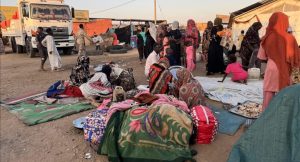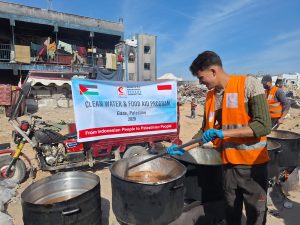Rome, MINA – In a new report, the UN identifies 10 countries worldwide at high risk in terms of food security, more than half of them in Africa.
According to the UN Food and Agriculture Organization (FAO) report, the countries at risk are Yemen, South Sudan, Venezuela, Sudan, Zimbabwe, Cameroon, Burkina Faso, Haiti, Afghanistan, and Nigeria.
In the report for this April to June, high-risk countries are defined as those where a new emergency or significant deterioration of the current situation is likely, with potentially severe effects on agriculture and food security, as quoted by Anadolu Agency.
The FAO aims to proactively mitigate and prevent disasters before they start to impact food security.
Also Read: EU Commissioner Says Israel Blocked Her Entry to Gaza During Egypt Visit
The report said that serious impacts on food security and agriculture are commonly seen in countries facing a longstanding conflict or economic crisis.
Yemen
As a country facing a longstanding conflict, Yemen is facing a severe humanitarian crisis, with some 24 million people estimated to be in need of humanitarian assistance, according to the report.
“Due to the protracted conflict, the economic situation of Yemen is likely to continue to deteriorate, this could result in further price shocks for essential food and non-food commodities, and therefore could further compromise access to food,” the FAO report said.
Also Read: Thousands Rally in Paris on International Day of Solidarity with Palestinians
South Sudan
South Sudan’s more than five-year-old conflict has left the country in a dire humanitarian and macroeconomic situation.
The report highlighted around 4.14 million people were displaced and 6.87 million people are expected to be food insecure.
Venezuela
Also Read: RSF Kills State News Agency’s Director in El-Fasher, Detains Several Journalists
Venezuela, facing hyperinflation since November 2016, is beset by shortages of food, medicine, healthcre services, and basic supplies.
According to a 2018 survey of living conditions by three universities, 80 percent of Venezuelan households are food insecure and 90 percent have income insufficient to buy food.
“In the coming months, the food security situation [in Venezuela] is not expected to improve and emigration is likely to continue,” FAO said.
Sudan
Also Read: Global Movement to Gaza to Hold Coordinated Rallies in 13 Cities on International Day of Solidarity
Sudan’s ongoing economic crisis disrupts public services, impacts agricultural activities, and pushes up prices for staple foods.
The price hikes “will continue to constrain food access among the most vulnerable people, who seasonally increase their reliance on markets during the lean season,” according to the FAO report.
Zimbabwe
Zimbabwe’s currency crisis has worsened since 2018, with significant spikes in the prices of fuel, food, and other goods.
Also Read: UN Urges Urgent Action as Human Trafficking Fears Rise in RSF-Controlled Fasher
“An estimated 31 percent of Zimbabwe’s rural population – 2.9 million people – will require urgent action to protect and save livelihoods, reduce food consumption gaps, and minimize acute malnutrition, between February and May 2019,” FAO said.
Cameroon
Almost 1.1 million people in Cameroon are facing food insecurity due to insecurity and the arrival of refugees, the crisis in its northwest and southwest regions, and incoming refugees from Central African Republic.
“The frequent lockdown and ghost town days are affecting economic activities, the functioning of markets and the start of the agricultural season,” according to the report.
Also Read: Russia Warns Trump’s Gaza Plan Could Enable “Uncontrolled Experiments” on Occupied Territory
Burkina Faso
Due to armed groups, the security situation in Burkina Faso has worsened since 2018, with over 687,000 people facing food insecurity.
“Violence is likely to trigger additional displacements for a total estimated of 190,000, in a context where access to those in need is difficult,” the report stated.
Haiti
Also Read: Israeli Attack on Syria Kills 13, Including Women and Children
“In Haiti, an unfavorable cropping season compounded with high inflation has led to increased levels of food insecurity,” said the report.
The political situation in the country has caused 2.6 million people to be severely insecure.
Afghanistan
An intense drought in most of the country in 2018 resulted in food insecurity.
Also Read: Bin Salman: Normalization With Israel Only Possible With Concrete Guarantees of Palestinian State
As of March, heavy rain and flooding is expected to impact around 250,000 people.
Nigeria
“Communal clashes between pastoralists and farmers were frequent, particularly in Adamawa, directly affecting the livelihood assets and food security of the local population,” said the report.
Food security issues in Nigeria have lessened compared to previous years, but approximately 4.9 million people are expected to be food insecure this summer.
Also Read: Syrian President Rejects Federalism, Says Coastal Region Remains National Priority
Last August, an African swine fever (ASF) outbreak — said to affect pigs and wild bears with up to 100% fatality — threatened to spread to Asia.
Also in Asia, a Fall Armyworm (FAW) insect native to tropical and subtropical regions of the Americas spread over Central and West Africa and some parts of Asia.
“The ASF virus survives in cold or hot weather, when dried or cured in pork products, and is resistant to some disinfectants,” the report stated.
“FAW is likely to spread to other parts of Asia, with Southeast Asia and southern China most at risk.”(R/R04/P2)
Also Read: Activist Unfurls Palestinian Flag During German Parliament Session, Protesting Gaza Policy
Mi’raj News Agency (MINA)































 Mina Indonesia
Mina Indonesia Mina Arabic
Mina Arabic